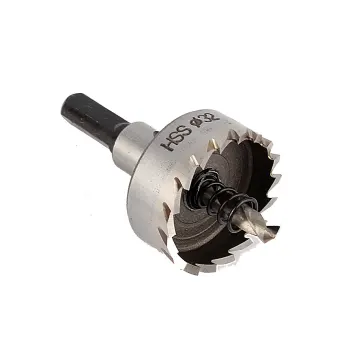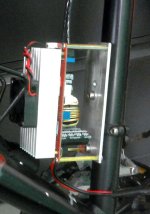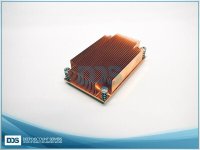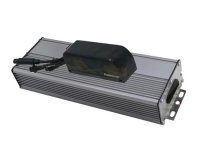My original plan was to have a two-piece baseplate, and the phaserunner itself would bridge holding them both together. The baseplate would then be attached to a seat-tube by two large U-bolts.
The reason for using two pieces was about cutting the half-moon slot. I've used hole-saws before with success, and a 1-1/4 inch hole-saw would be a hair under-diameter for the seat-tube in question. That would leave just enough meat on it to finish it off with a coarse half-moon hand-file to fit. Of course a machinist could make it a perfect fit straight from the cut.

Anyways, take two thick aluminum rectangular plates and slap them together with clamps. If the foot-print that the Phaserunner sits on is 3-inches by 6 inches (thickness to vary according to what is handy, with minimum thickness being 1.5 inches), then you would have the shop cut you off two pieces of 3 X 3 inches. Any of these given dimensions can be larger, but I'd say these are useful minimums.
Two 1.5-inch thick plates clamped together face-to-face make them 3.0 thick.
Since the space for the heads of the four bolts that hold the Phaserunner onto the heat-sink would be right in the half-moon groove, those were the first four holes I drilled. First the four 4mm holes, and then the four wider-diameter recesses for the heads of the bolts.
If there's a trick to doing this without a drill press...drill from both ends to the center, since drill bits have a tendency to wander slightly, and it doesn't matter if the pilot hole is a hair off in the center of the piece, as long as the two ends have a fairly centered hole opening. The first pilot hole was probably using a 3/16 drill bit, and once it was drilled from both ends to the center, I reamed it out with a long 1/4 inch bit. Then, I drilled on the mated pieces with the 1.25 hole saw from both ends towards the center, with the pilot hole keeping it fairly close to straight. I had swapped the stock central bore-bit on the hole-saw with a very long bit from McMaster-Carr. Split the two pieces, and the hole becomes two round half-moons.

I couldn't find the aluminum stock I was looking for, and settled on what they had, I think it was 2 X 2 inch square rod, and I had them chop me off four pieces 4-inches long (very cheap, and the width of an 18650 battery pack). Three of them sideways made the baseplate 4 X 6, and the fourth piece was extra, so I converted it into two tube-clamps, instead of just throwing it away.
I used one of my favorite tricks for the threads. I could have tapped threads into the pieces, but I drilled four recesses that were the diameter of a steel nutsert, and just epoxied four of them in. When epoxying a nutsert into a hole, bolt everything together, and the bolts hold the nutserts in the proper alignment while the epoxy dries, plus...grease the bolt and nutsert threads before mixing-up the epoxy (so excess epoxy doesn't weld the threads).
Once the three aluminum pieces were epoxied side-by-side to each other, I could flat-file the sides and top to smooth them out, and also use a half-moon file to clean up the roughness in the half-moon slot. For the final facing of the flat Phaserunner seat, I taped sandpaper on a flat sheet of hard plastic to lap it. Thermal paste would have filled-in any filing marks, but...I had some time on my hands, so why not?
If I was selling Phaserunners, I would just buy baseplates from MrDude_1.







